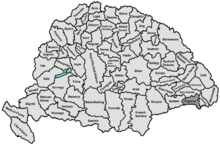Fogaras County
This article needs additional citations for verification. (June 2012) |
| Fogaras County Comitatul Făgăraş Comitatus Fogarasensis Fogaras vármegye Komitat Fogarasch | |
|---|---|
| County of the Kingdom of Hungary | |
| 1876–1920 | |
 | |
| Capital | Fogaras |
| Area | |
• 1910 | 2,444 km2 (944 sq mi) |
| Population | |
• 1910 | 95,174 |
| History | |
• Established | 1876 |
• Treaty of Trianon | 4 June 1920 |
| Today part of | Romania |
| Făgăraş is the current name of the capital. | |
Fogaras was an administrative county (comitatus) of the Kingdom of Hungary. Its territory is now in central Romania (south-eastern Transylvania). The capital of the county was Fogaras (Făgăraș).
Geography
Fogaras county shared borders with Romania and the Hungarian counties Szeben, Nagy-Küküllő and Brassó. The river Olt forms most of its northern border. The ridge of the southern Carpathian Mountains forms its southern border. Its area was 2433 km² around 1910.
History
The Fogaras (Făgăraș in Romanian) region was an administrative unit of the Kingdom of Hungary since the 15th century. Fogaras county was formed in 1876, when the administrative structure of Transylvania was changed. In 1918 (confirmed by the Treaty of Trianon 1920), the county became part of Romania. Its territory lies in the present Romanian counties Braşov and Sibiu (the westernmost part).
Demographics
In 1900, the county had a population of 92,801 people and was composed of the following linguistic communities:[1]
Total:
- Romanian: 83,445 (89,9%)
- Hungarian: 5,159 (5,6%)
- German: 3,627 (3,9%)
- Slovak: 32 (0,0%)
- Ruthenian: 5 (0,0%)
- Serbian: 3 (0,0%)
- Croatian: 1 (0,0%)
- Other or unknown: 529 (0,6%)
According to the census of 1900, the county was composed of the following religious communities:[2]
Total:
- Eastern Orthodox: 60,220 (64,9%)
- Greek Catholic: 23,850 (25,7%)
- Lutheran: 2,737 (2,9%)
- Roman Catholic: 2,454 (2,7%)
- Calvinist: 2,225 (2,4%)
- Jewish: 873 (0,9%)
- Unitarian: 437 (0,5%)
- Other or unknown: 5 (0,0%)
In 1910, county had a population of 95,174 people and was composed of the following linguistic communities:[3]
Total:
- Romanian: 84,436 (88,7%)
- Hungarian: 6,466 (6,8%)
- German: 3,236 (3,4%)
- Slovak: 55 (0,0%)
- Serbian: 3
- Croatian: 5
- Ruthenian: 20
- Other or unknown: 953 (1,0%)
According to the census of 1910, the county was composed of the following religious communities:[4]
Total:
- Eastern Orthodox: 61,881 (65,0%)
- Greek Catholic: 23,651 (24,8%)
- Roman Catholic: 3,024 (3,2%)
- Lutheran: 2,768 (2,9%)
- Calvinist: 2,441 (2,6%)
- Jewish: 905 (1,0%)
- Unitarianist: 482 (0,5%)
- Other or unknown: 22 (0,0%)
Subdivisions
In the early 20th century, the subdivisions of Fogaras county were:
| Districts (járás) | |
|---|---|
| District | Capital |
| Alsóárpás | Alsóárpás, RO Arpaşu de Jos |
| Fogaras | Fogaras, RO Făgăraş |
| Sárkány | Sárkány, RO Şercaia |
| Törcsvár, RO Bran | Zernest, RO Zărneşti |
| Urban districts (rendezett tanácsú város) | |
| Fogaras, RO Făgăraş | |
References
- ^ "KlimoTheca :: Könyvtár". Kt.lib.pte.hu. Retrieved 2012-12-06.
- ^ "KlimoTheca :: Könyvtár". Kt.lib.pte.hu. Retrieved 2012-12-07.
- ^ "KlimoTheca :: Könyvtár". Kt.lib.pte.hu. Retrieved 2012-06-19.
- ^ "KlimoTheca :: Könyvtár". Kt.lib.pte.hu. Retrieved 2012-06-19.


